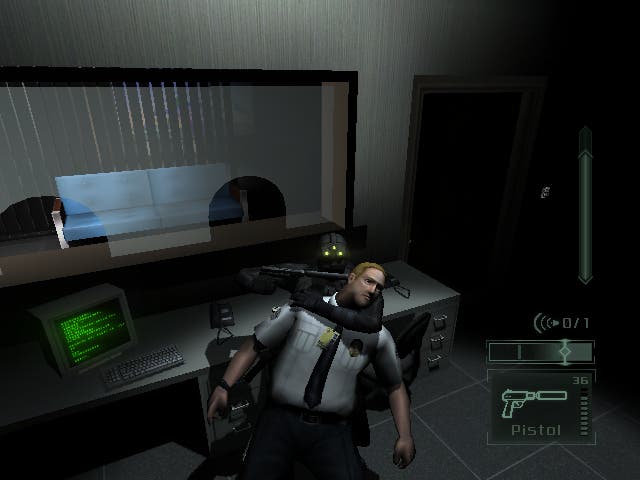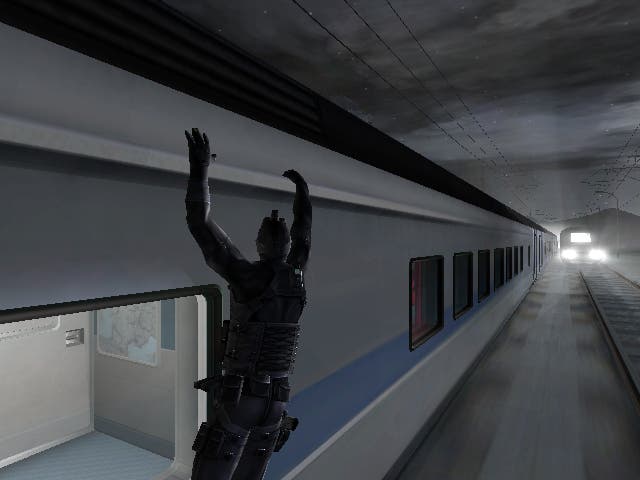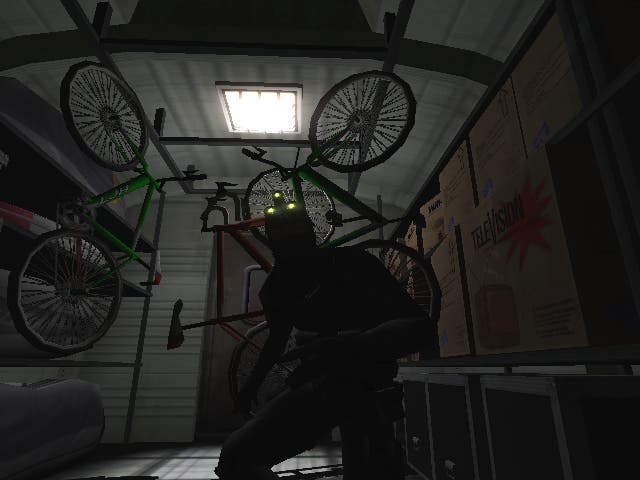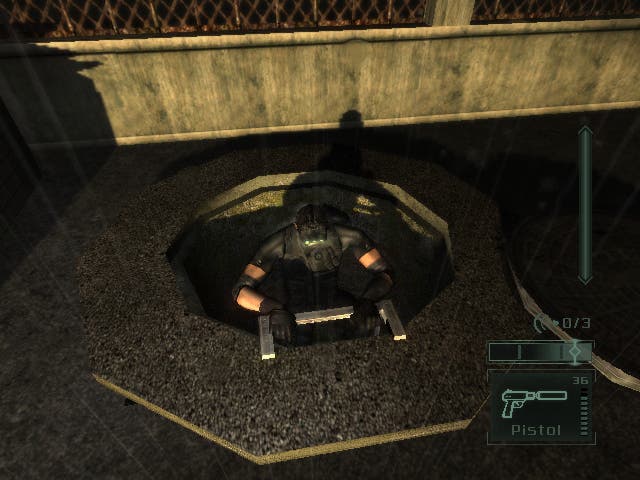Splinter Cell: Pandora Tomorrow
Profoundly in love with Pandora? Or growing pains for Sam Fisher?
How's your smash-o-meter today? Wound tighter than a G-string? You might want to buy some extra pads, or at the very least some extra padding, because Uncle Sam Fisher is back to taunt us again. You half expect the grizzled old sleuth to appear upside down at your living room window, decked out in his best rubber perv suit, pointing a laser sighted silenced pistol right between your frazzled and disconsolate eyes - all the while singing 'That'll Be The Day'.
Taking in the spectacle he's clocked the pile of broken joypads, and clicked on his thermal goggles and duly noted the broken heart beating itself to death after another hapless plan is clinically foiled again, but in his dry unflappable way he's having none of it. Broken spirit or not, he knows how hard it is being a master of espionage. He's the one that's had to die those thousand deaths. "Schtop!" Is he a Dutchman? "Just like the Grolsch, you can't rush stealth. You have to take it easy. Observe the movements. Breathe. Be patient." Easier said than done, Sam, my old china.
Smashy or nicey?

Sometimes the amount you enjoy a videogame is directly proportional to your ability to tolerate acute levels of frustration. One game almost specifically designed to test Fisher's smash-o-meter calibration is undoubtedly Ubisoft's pseudo-sequel to Splinter Cell. Much like Conflict: Desert Storm II wasn't really a proper sequel to Pivotal's Iraqi-bashing smash, neither is Ubisoft's Shanghai-studio coded effort. It's essentially an exceptionally well-polished 'second episode' if you like. More of the same to keep the faithful happy while the Montreal studio toils away on a bona-fide update.
Although there's been much ballyhoo over the French studio's efforts on the multiplayer side of the game (more of which later), it's best not to get too carried away about a mode that probably five per cent of the game's (console) owners will ever get to experience. Whatever Xbox Live goodness that lies within, this ostensibly 'filler' release is almost entirely about the single-player experience for most of you looking to part with your cash.
So what's new? The truth is this will come across to most of you as a broadly similar experience in virtually every way - which is either a good thing or a very bad thing depending on how you got on with the original. Everything from the front end, to the in-game FMV, right down to the game engine and soundtrack is virtually indistinguishable from the original, as is the overall gameplay, control method and the atmosphere. To the untrained eye this has got 'mission pack' running through it like a stick of rock, possibly to a fault, but it will most definitely service the needs of the many fans of the first Fisher title, while perhaps sticking too closely to the unforgiving brief to tempt over too many new converts.
Not a cash-in after all?

Delve deeper, though, and numerous minor improvements and tweaks will convince you that this isn't perhaps the cash in it appears to be. As with the first Splinter Cell, PT relies heavily on an often stupendously detailed and versatile graphics engine that still allows much of the gameplay to stand out from its stealth rivals despite the near saturation point the genre is experiencing. The key to the gameplay is still its trademark lighting effects that gives Ubisoft the means to build eight stunning levels that not only hit the mark in visuals terms, but have been crafted with thought and precision to let the player decide what the best course of action is in most situations, with often multiple routes to success.
Avoidance is, of course, the key. Stumble into almost anyone and you'll risk compromising the entire mission, such is the game's insistence that you behave like a ghost throughout. However, having listened to feedback, it's apparent that several fundamental things have changed to make the game just a little more fun and slightly less fussy than it was when it first appeared on Xbox.
Top of the list has to be the alarm system. On most levels you get a 'three strikes and you're out' system that give you two chances to screw up before the mission is aborted, but rather than forcing you to carry these alarms through the entire convoluted level, the game often resets these back to zero upon reaching certain boundaries - usually near a check point - and it's a godsend that ensures consistent progress rather than a regretful expletive strewn slog through previous saved games.
Another helpful tweak is the fact that the enemy AI has been slightly dumbed down, so that they give up the chase slightly quicker than before - perhaps convincing themselves that they're hearing things after a short period of alertness before going back to a more observable, predictable pattern of behaviour. It may not look as ambitious, but it certainly makes for a far more playable experience, which is what counts.
Roger Whittaker eat your heart out

Other minor additions include Sam's ability to whistle in order to attract a guard - usually to a darkened corner before you crack him over the head, while save points appear to be more regular than they were before - although can have a tendency to stop appearing when you need them most. A few new moves have also made it into the mix, such as the SWAT turn, which lets you dart between pillars unnoticed, while the roll lets you evade an enemy quicker in theory, although both moves feel largely superfluous for the most part. Underpinning the general improvements is the context sensitive control system that PS2 and Cube owners with be familiar with, but Xbox owners won't. It makes it a breeze to do the simple things such as peering through a keyhole, picking a lock, or even opening a door while carrying a body - always a stupidly annoying oversight in the original that could trip you up.
Even little things like targeting with the sniper rifle has been sorted out, as has the lack of health and ammo situation, and with perhaps one of - if not the best - third-person camera systems ever implemented, the game is built on a fine foundation that takes a huge amount of the irritation out of playing by its strict rules.
However, let's not kid ourselves for one moment that this is at any point an easy or perfect game. Although it may well be a reflection of this reviewers lack of stealth brilliance, the last two levels alone took a good seven hours to crack, and the whole game weighed in at well over 20 hours - largely padded out by a mere handful of points in the game that bordered on insanely hard. Although, now being aware of the simple solutions to the very hardest parts of the game, we'd guess that it would be easily possible to crack the game in well under half the time with practice.
When just being good at something isn't enough

Being good at the game simply isn't enough sometimes. There were memorable occasions when we knew exactly what to do, but were just thwarted by some basic inconsistencies. For example, how exactly does an enemy grunt survive a sniper shot to the face and then react quick enough to pull his gun out and shoot straight back with unerring accuracy? We don't know, but that's exactly what happened time after time on one bitterly frustrating section. Also, just why does the game make it so unfeasibly inconsistent when you're trying to grab someone from behind? If they just happen to turn slightly as you approach, the chance is lost in an instant - and often the margin between success and failure is so slim you'd swear you could fit a Rizla between the two.
In what appears to be a bizarre nutshell, it's exactly this "Gah, I nearly did it! One more go!" dynamic that keeps you anchored to the joypad for hours on end determined not to let what seems to be an arbitrary problem beat you. It's also quite likely this unpredictable and pedantic style of game will have you infuriated beyond belief and too wound up to want to go on. It's definitely the leading contender for Marmite game of the year, if they were ever to consider sponsoring games that polarised opinion so heavily. Fortunately for Ubisoft, we liked the challenge and appreciated the improvements, while also simultaneously acknowledging that's it's by no means perfect.
One such area that seems half-baked compared to its rivals is the between level cut-scenes that splice fake newsreel clips with some largely forgettable cut-scenes. Although the story is an improvement over Splinter Cell's (with some great named actors doing the voiceovers to great effect), it's hard to imagine Tom Clancy himself had too much to do with it other than banking the royalty advance. No one in their right minds should really wish for the overblown 20 minute cut-scene/codec sequences of Metal Gear Solid 2, but something that matches it for cinematic excellence would have been great to witness in what is arguably one of the most sumptuous looking games ever made. To intersperse the levels with FMV that doesn't even match the style of the game is just odd and looks bolted on like an afterthought.
Variety show

The overall variety used in each of the eight levels is definitely one of the main hooks that drags you through the game. Right from the first level, with its delightful water effects and stunningly convincing vegetation, you know you're in for a treat. The third level, based aboard a train from Paris to Nice, just takes the biscuit, and has some genuinely hair-raising moments that will live long in the memory. The game then throws up all manner of interesting environments including a jungle, a TV Station and an Airport, so you couldn't accuse it of feeling samey. Possibly the only gripe about the game engine as such is the fact you can't interact with it a great deal, and that adding in more advanced physics would have opened up the gameplay a touch. Still, like we said, if you want more of the same, but better, here it is. Just don't think of this as the sequel and you'll be fine.
While it's easy to see that the game engine is top notch for the most part, its glory extends far beyond looking pretty. The fact that it takes something as basic as a lighting effect and makes an entire game out of it is surely one of the most well implemented design decisions ever. It still hasn't quite been used to its potential, though - why don't these moron enemies carry torches for example? Why does shooting the lights out not send everyone into panic, as opposed to their brief bewilderment, before they glumly carrying on their aimless wandering? Still, it's easy to pick holes and be uncharitable about the effect - the fact is it contributes to making the game one of the most fun, tense and downright atmospheric gaming experiences there has ever been, albeit let down by some moments of bloody-minded design.
So what of the multiplayer? It's a cunningly crafted two-on-two battle of wits set across eight specifically designed multiplayer maps. With three modes of play to choose from (Neutralisation, Extraction, Sabotage), one team play as the Shadownet spies (i.e the Sam Fishers) on a mission to basically perform one of three worthy goals (destroy virus, nick virus and bring it back, or, um sabotage the virus by placing a modem nearby - whuh?) and the other play as the Argus Corporation Mercenaries on a mission to kill these sneaky blighters.
Balancing act

What's immediately apparent is that it's been balanced incredibly carefully. Whichever side you plump for, there are several pros and cons to take into account. The spies, sneaky buggers that they are, can climb into ducts, over fences and generally have access to bits of the map that the mercenary grunts haven't, as well as being blessed with gadgets such as thermal and night vision, and the good old sticky shocker. The mercs, on the other hand, operate in first-person, and have one powerful advantage in the form of their machine gun, as well as wall mounted spy traps and mines to snare the unwary. But their own forms of enhanced vision - electro magnetic and motion tracking - seem more of a hindrance than anything, so you're heavily disadvantaged by not actually being able to see as well, nor being able to follow the spies through their hidey holes.
As a balancing act it's brilliant, as you never feel you have the upper hand whichever side you're on. In addition, with just two on each side, and three places to defend or attack, you're always feeling short handed. Admittedly we didn't do particularly well, as our opponents clearly knew the maps inside out and we found it hard to tell who was friend or foe half the time (one black shape looks much like another when dodging between the shadows). It would have perhaps been better to support more players, maybe eight in total, but as it is it makes a refreshing change to the deathmatch slog that most games pass off as their multiplayer modes. It's almost worth thinking of the multiplayer as a totally different game to the single-player campaign, and definitely doesn't look or feel like a bolted on extra. In many senses it is a different game, and it's no surprise to learn that an entirely different team toiled away for two years to hone what is among the best online gaming experiences ever. It even appears to be using a different game engine (are our eyes deceiving us?), and feels distinctly different as well, with a distinctly different pace and some moves added and some taken away.
Tomorrow Never Dies
To sum up, recommending Pandora Tomorrow is easy. Its single-player campaign, despite a few minor but welcome enhancements is broadly a case of more of the same, and we can't entirely blame Ubi for deciding to milk its popularity because it's a damn good game in its own right. There were standout moments of gaming genius in there, and a handful of occasions that sent our smash-o-meter off the scale, but if you can put up with these then you're in for 20-odd hours of richly atmospheric gameplay. If the idea of multiplayer attracts you as well, then it's basically a must-have, especially if you can convince a few mates to get involved so that you're learning the ropes together. Anyone with affection for Mr Fisher shouldn't hesitate in buying this, but remember that extra padding...


